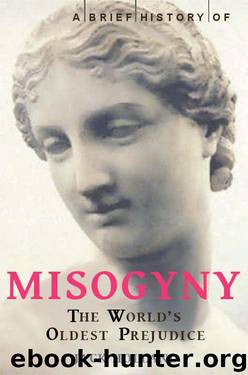A Brief History of Misogyny: The World's Oldest Prejudice by Jack Holland

Author:Jack Holland
Language: eng
Format: azw3, epub
Tags: Politics, Women's Studies, Religion, Social Science, History
ISBN: 9781780338842
Publisher: Robinson, London
Published: 2006-03-01T11:00:00+00:00
6
VICTORIANS’ SECRETS
Misogyny is far from unique to Western civilization. That became clear to Europeans as, from the early sixteenth century onwards, they began expanding into regions of the world with which before they had little or no contact. They encountered complex civilizations at least as old as (and sometimes far older than) their own, and equally (if not in some ways more) sophisticated. Meanwhile, in other, previously unexplored or unknown areas, they discovered cultures that were, at a technological and social level, simpler than anything they had ever seen. But one thing they all shared: Neither the primitive nor the sophisticated societies lacked for prejudices against women.
Sometimes these prejudices took on an almost universal character, as with the taboos relating to menstruation. From the Macusis tribe of South America, who hung pubescent girls in the highest hammocks, then submitted them to a beating with rods,223 to the Hindu Brahmins of India, who believed that a visit to a menstruating woman was one of the seven things a man might do to forfeit his chance of a happy or a long life,224 all over the world men’s terror of menstruating women invested them with extraordinary powers to do harm.
However, it was not the crude superstitions of tribes – who lived sometimes at the level of Stone Age man – that most impressed Europeans at the beginning of the modern era, but the complex and often profoundly contradictory views of women that they encountered when they began developing trading relations with the powerful civilizations of the East, particularly those of India and China. Hinduism and Buddhism had developed in India over 1,000 years between 1500 BC and 500 BC, with Taoism and Confucianism in China emerging between the seventh and fifth centuries BC. Both civilizations retained traces of much earlier cultures, with what some have interpreted as matriarchal elements. In the earliest Chinese creation myth, for example, it was a goddess Nu Wa who moulded the human race from clay. Archaeological investigation of the earliest civilizations in the Indus valley reveals a plethora of terracotta figurines of naked women, and the later Hindu pantheon contains several powerful goddesses, including Parvati, Durga, Sakti and Kali.225 Whatever conclusions we might draw from this about the status of women in these early societies, one thing is beyond doubt. Sexual and religious rituals in both civilizations recognized and at times exalted the role of women. Yet, alongside this was a profound contempt, especially noticeable in Confucianism, Hinduism and Buddhism.
By the middle of the eighteenth century, Britain dominated the Indian subcontinent both politically and economically, a rule that would last until 1947 when India became independent. The British and other Europeans were shocked, confused and fascinated by Indian sexual attitudes and behaviour. Writing about the numerous temple prostitutes found in India, the eighteenth-century missionary Abbé Dubois declared, ‘A religion more shameful or indecent has never existed amongst a civilized people.’226
Europeans easily found evidence of the low social status of women; it complemented many of their own, Western-based prejudices.
Download
A Brief History of Misogyny: The World's Oldest Prejudice by Jack Holland.epub
This site does not store any files on its server. We only index and link to content provided by other sites. Please contact the content providers to delete copyright contents if any and email us, we'll remove relevant links or contents immediately.
| General | Men |
| Women in History |
Cecilia; Or, Memoirs of an Heiress — Volume 1 by Fanny Burney(32075)
Cecilia; Or, Memoirs of an Heiress — Volume 3 by Fanny Burney(31469)
Cecilia; Or, Memoirs of an Heiress — Volume 2 by Fanny Burney(31419)
The Great Music City by Andrea Baker(30797)
We're Going to Need More Wine by Gabrielle Union(18641)
All the Missing Girls by Megan Miranda(14789)
Pimp by Iceberg Slim(13798)
Bombshells: Glamour Girls of a Lifetime by Sullivan Steve(13698)
Fifty Shades Freed by E L James(12925)
Talking to Strangers by Malcolm Gladwell(12889)
Norse Mythology by Gaiman Neil(12861)
For the Love of Europe by Rick Steves(11558)
Crazy Rich Asians by Kevin Kwan(8898)
Mindhunter: Inside the FBI's Elite Serial Crime Unit by John E. Douglas & Mark Olshaker(8722)
The Lost Art of Listening by Michael P. Nichols(7170)
Enlightenment Now: The Case for Reason, Science, Humanism, and Progress by Steven Pinker(6879)
The Four Agreements by Don Miguel Ruiz(6326)
Bad Blood by John Carreyrou(6285)
Weapons of Math Destruction by Cathy O'Neil(5848)
